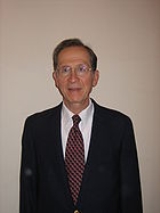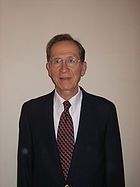
Charles H. Henry
Encyclopedia

Illinois
Illinois is the fifth-most populous state of the United States of America, and is often noted for being a microcosm of the entire country. With Chicago in the northeast, small industrial cities and great agricultural productivity in central and northern Illinois, and natural resources like coal,...
, USA, on May 6, 1937. He received an MS.
Master of Science
A Master of Science is a postgraduate academic master's degree awarded by universities in many countries. The degree is typically studied for in the sciences including the social sciences.-Brazil, Argentina and Uruguay:...
degree in physics in 1959 from the University of Chicago
University of Chicago
The University of Chicago is a private research university in Chicago, Illinois, USA. It was founded by the American Baptist Education Society with a donation from oil magnate and philanthropist John D. Rockefeller and incorporated in 1890...
, and a PhD
Doctor of Philosophy
Doctor of Philosophy, abbreviated as Ph.D., PhD, D.Phil., or DPhil , in English-speaking countries, is a postgraduate academic degree awarded by universities...
degree in physics in 1965 from the University of Illinois, under the direction of Charlie Slichter
Charles Pence Slichter
Charles Pence Slichter is an American physicist, best known for his work on nuclear magnetic resonance and superconductivity....
. In March, 2008, he was featured in an article in the Physics Illinois News, a publication of the Physics Department of the University of Illinois.
Henry's entire professional career was spent in the research area of Bell Laboratories in Murray Hill
Murray Hill, New Jersey
Murray Hill is an unincorporated area within portions of both Berkeley Heights and New Providence, located in Union County in northern New Jersey, United States....
, New Jersey
New Jersey
New Jersey is a state in the Northeastern and Middle Atlantic regions of the United States. , its population was 8,791,894. It is bordered on the north and east by the state of New York, on the southeast and south by the Atlantic Ocean, on the west by Pennsylvania and on the southwest by Delaware...
. He joined Bell Laboratories in 1965 as a member of technical staff
Member of Technical Staff
A Member of Technical Staff is the title for permanent research staff at some institutions and companies. It is roughly equivalent to an assistant professor or associate professor at a university or a chief technical officer in a technology startup company.A Distinguished Member of Technical...
. From 1971 to 1975, he was head of the Semiconductor Electronics Research Department. He retired from Lucent Technologies
Lucent Technologies
Alcatel-Lucent USA, Inc., originally Lucent Technologies, Inc. is a French-owned technology company composed of what was formerly AT&T Technologies, which included Western Electric and Bell Labs...
Bell Laboratories in 1997 as a Distinguished Member of Technical Staff. He has published 133 technical papers and holds 28 patents, including a 1976 patent covering what is now called the quantum well laser
Quantum well laser
A quantum well laser is a laser diode in which the active region of the device is so narrow that quantum confinement occurs. The wavelength of the light emitted by a quantum well laser is determined by the width of the active region rather than just the bandgap of the material from which it is...
.
Throughout his career, Henry worked at the forefront of semiconductor-based optical technologies and science: light-emitting diodes, semiconductor lasers, and
photonic integrated circuit
Photonic integrated circuit
A photonic integrated circuit or integrated optical circuit is a device that integrates multiple photonic functions and as such is analogous to an electronic integrated circuit...
s. He was an inventor as well as an experimenter, with a particular interest in understanding the theory underlying semiconductor optical devices.
Quantum wells
The idea of the quantum wellQuantum well
A quantum well is a potential well with only discrete energy values.One technology to create quantization is to confine particles, which were originally free to move in three dimensions, to two dimensions, forcing them to occupy a planar region...
occurred to Henry in late 1972. While thinking about optical waveguides, Henry suddenly realized that a double heterostructure
Double heterostructure
A double heterostructure is formed when two semiconductor materials are grown in to a "sandwich". One material is used for the outer layers , and another of smaller band gap is used for the inner layer. In our example, there are two AlGaAs-GaAs junctions at each side of the inner layer...
is a waveguide for electrons, and that a heterostructure with a thin central active layer would have discrete electron modes. Such a heterostructure was later named a quantum well
Quantum well
A quantum well is a potential well with only discrete energy values.One technology to create quantization is to confine particles, which were originally free to move in three dimensions, to two dimensions, forcing them to occupy a planar region...
, and the modes are the electron states of the quantum well.
Henry further realized that these discrete electron states would greatly alter the optical absorption edge of the semiconductor. Instead of the absorption being a smooth curve steeply rising with optical energy, it would consist of a series of steps.
In early 1973, he proposed to R. Dingle that he look for these steps, and they were observed and reported in 1974 in a paper the pair wrote with W. Wiegmann.
After Dingle’s experiment showed the reality of Henry's predicted quantum effects, Henry realized that the quantum well structure would alter the density of states of the semiconductor and result in an improved semiconductor laser. He also realized that the laser wavelength could be changed merely by changing the thickness of the thin quantum well layers, whereas in a conventional laser, a change in wavelength requires a change in layer composition.
On March 7, 1975, Henry and Dingle filed a patent entitled "Quantum Effects in Heterostructure Lasers," which was issued on Sept. 21, 1976. The story of the origin of the quantum well laser
Quantum well laser
A quantum well laser is a laser diode in which the active region of the device is so narrow that quantum confinement occurs. The wavelength of the light emitted by a quantum well laser is determined by the width of the active region rather than just the bandgap of the material from which it is...
is told by Henry in the foreword to Quantum Well Lasers, edited by Peter S. Zory, Jr. (1993).
Other achievements
In addition to his seminal work on quantum wells and the invention of the quantum well laserQuantum well laser
A quantum well laser is a laser diode in which the active region of the device is so narrow that quantum confinement occurs. The wavelength of the light emitted by a quantum well laser is determined by the width of the active region rather than just the bandgap of the material from which it is...
, Henry made a significant contribution to understanding the noise properties of semiconductor lasers. In a widely cited 1982 paper, he introduced M. Lax's "alpha parameter" for the first time into semiconductor laser physics and used it to explain why the linewidth of a semiconductor laser is about 50 times greater than that predicted by the theory of Schawlow and Townes. The alpha parameter remains a basic laser property that aids in understanding a variety of semiconductor laser behaviors.
Early in his career, Henry identified the source of red light emission in gallium phosphide LEDs
LEDS
LEDS can be initials for:* Law Enforcement Data System* Link Eleven Display System* Low Energy Dislocation Structure* Land Electronic Defence System * LEDs * Life-Events and Difficulties Schedule...
. In 1968, he and coworkers reported that the red luminescence originated from an electron-hole pair bound to a nearest neighbor donor-acceptor pair composed of zinc and oxygen. Subsequently, red as well as green GaP LEDs were manufactured and used as indicator lights in a variety of applications.
Beginning in the mid-1980s, Henry (with R. F. Kazarinov) initiated a new photonic integrated circuit
Photonic integrated circuit
A photonic integrated circuit or integrated optical circuit is a device that integrates multiple photonic functions and as such is analogous to an electronic integrated circuit...
technology based on silica waveguides fabricated on silicon wafers.
Arrayed waveguide grating
Arrayed waveguide grating
Arrayed waveguide gratings are commonly used as optical multiplexers in wavelength division multiplexed systems. These devices are capable of multiplexing a large number of wavelengths into a single optical fiber, thereby increasing the transmission capacity of optical networks considerably.The...
routers, invented by C. Dragone, were fabricated with this technology and used for wavelength-division multiplexing
Wavelength-division multiplexing
In fiber-optic communications, wavelength-division multiplexing is a technology which multiplexes a number of optical carrier signals onto a single optical fiber by using different wavelengths of laser light...
, the simultaneous transmission of optical signals at different wavelengths over a single optical fiber
Optical fiber
An optical fiber is a flexible, transparent fiber made of a pure glass not much wider than a human hair. It functions as a waveguide, or "light pipe", to transmit light between the two ends of the fiber. The field of applied science and engineering concerned with the design and application of...
.
Henry returned to the physics of quantum noise
Quantum noise
Quantum noise is uncertainty of some physical quantity due to its quantum origin.In the case of number of particles , the quantum noise is also called shot noise. Most optical communications use amplitude modulation...
in 1996. With Kazarinov, he published "Quantum Noise in Photonics" (Rev. Mod. Phys. 68, 801–853 [1996]), which explained the physical nature of noise in optical communications. The basic equations governing noise phenomena were derived from first principles and applied to specific examples.
Awards and honors
Henry is a Fellow of the American Physical Society, the Institute of Electrical and Electronic Engineers, and the American Association for the Advancement of Science, and is a member of Sigma Xi.Henry has received the Morton Award (1999, IEEE), the Charles Hard Townes Award (1999, Optical Society of America), and the Prize for Industrial Applications of Physics (2001, American Institute of Physics). He is the recipient of an Alumni Award for Distinguished Service from the University of Illinois College of Engineering (2001).

